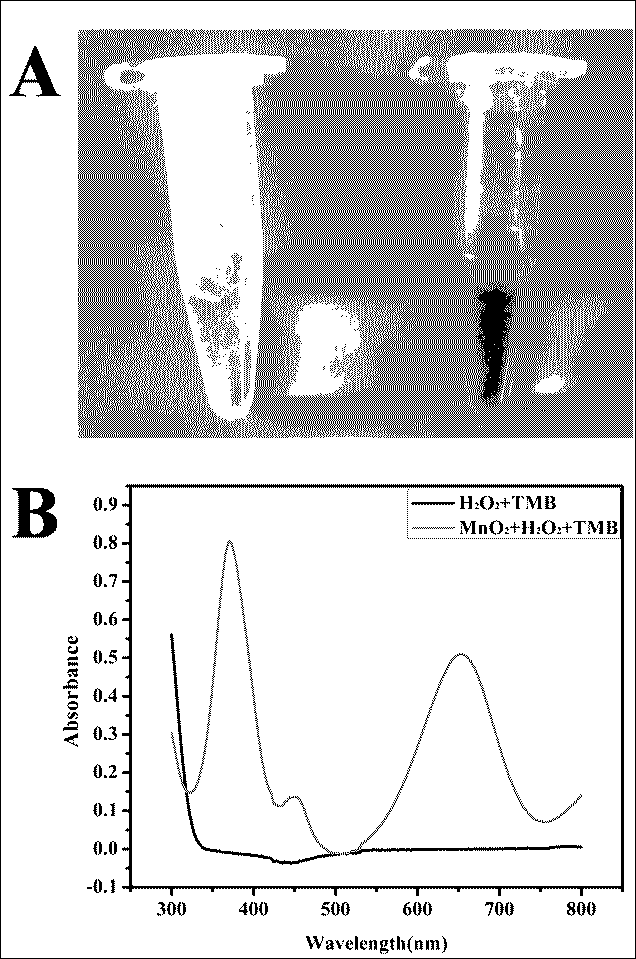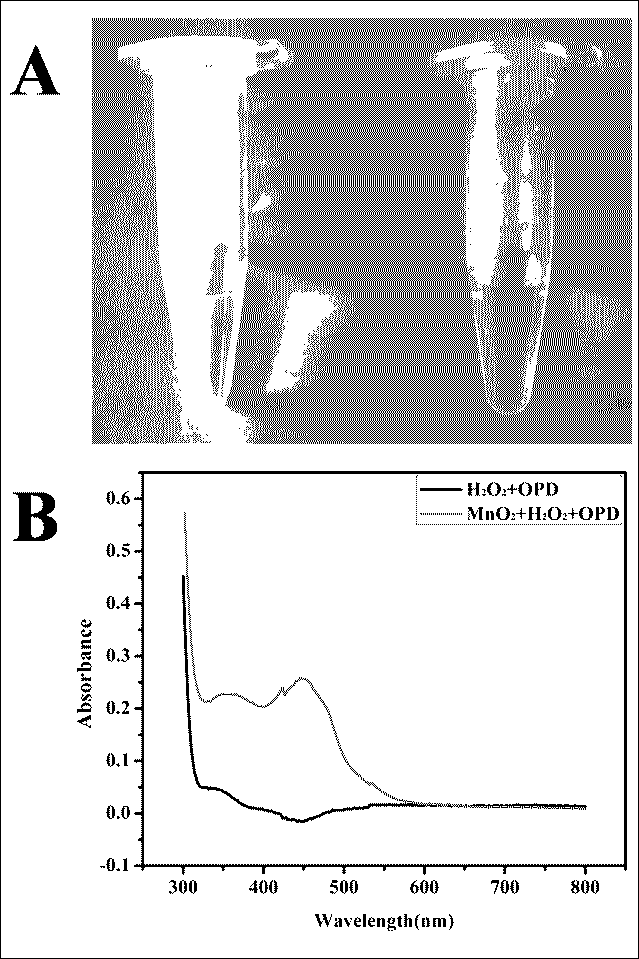An enzyme-free one-pot colorimetric detection method for glucose based on enzyme-like nanomaterials
A glucose and glucose oxidase technology, which is applied in the field of enzyme-free one-pot glucose color detection based on enzyme-like nanomaterials, can solve the problems of increased cost, difficult control, and complicated detection process, and achieve high temperature stability.
- Summary
- Abstract
- Description
- Claims
- Application Information
AI Technical Summary
Problems solved by technology
Method used
Image
Examples
Embodiment 1
[0034] MnO based on BSA template 2 Preparation of NSs:
[0035] (1) Mix BSA (final concentration 100 µg / mL) and manganese acetate aqueous solution (final concentration 2 mM) and incubate for 1 h;
[0036] (2) Add an aqueous solution of sodium hydroxide to the above mixed solution and mix well, shake and react for 24 h;
[0037] (3) Centrifuge the above reaction solution, remove the supernatant containing unreacted components, collect the precipitate, and store it at 4°C for future use; BSA can also be collected and purified by dialysis or filtration.
Embodiment 2
[0039] MnO 2 Analysis of enzymatic activity of NSs:
[0040] MnO 2 Mimic peroxidase activity analysis of NSs: The catalytic reaction system is composed of H 2 o 2 (1 mmol / L), the MnO obtained in the above examples 2 NSs (25 µg / ml), organic chromogen TMB (0.5 mmol / L) in acetate buffer (pH 3.5). After reacting at room temperature (25 °C) for 30 minutes, the absorbance at 650 nm was detected with a microplate reader. Such as figure 2 As shown, with TMB as the color reagent, MnO 2 NSs exhibit mimic peroxidase activity (black curve). In another control experiment, the MnO in the above experiment 2 NSs were replaced with the same volume of water as figure 2 As shown, without MnO 2 NSs have no mimetic activity (grey curve).
[0041] In another two groups of experiments, the organic chromogen was replaced by OPD and ABTS, and after reacting at room temperature (25 °C) for 30 minutes, the absorbance value at 650 nm was detected by a microplate reader. Such as imag...
Embodiment 3
[0044] MnO 2 pH optimization of NSs mimic enzyme activity:
[0045] MnO 2 pH optimization of NSs imitation peroxidase activity: the catalytic reaction system is composed of H 2 o 2 (1 mmol / L), MnO 2 NSs (25 µg / ml), organic chromogenic agent TMB (0.5 mmol / L) with different pH buffers (pH 1.0−2.0, glycine-hydrochloric acid buffer; pH 3.0−6.0, acetic acid-sodium acetate buffer; pH 7.0−8.0, phosphate buffer; pH 9.0, Tris-HCl buffer). After reacting at room temperature (25 °C) for 10 minutes, the absorbance at 650 nm was detected with a microplate reader. Such as Figure 6 Shown, MnO 2 NSs exhibited peroxidase activity at slightly acidic pH (pH 3.0−5.0), and the optimum pH was around 3.5 (black curve).
[0046] MnO 2 pH optimization of NSs imitation glucose oxidase activity: the catalytic reaction system contains glucose (1 mmol / L), MnO 2 NSs (25 µg / ml) and buffers of different pH (pH 1.0−2.0, glycine-HCl buffer; pH 3.0−6.0, acetic acid-sodium acetate buffer; pH 7.0−8.0, ...
PUM
 Login to View More
Login to View More Abstract
Description
Claims
Application Information
 Login to View More
Login to View More - R&D
- Intellectual Property
- Life Sciences
- Materials
- Tech Scout
- Unparalleled Data Quality
- Higher Quality Content
- 60% Fewer Hallucinations
Browse by: Latest US Patents, China's latest patents, Technical Efficacy Thesaurus, Application Domain, Technology Topic, Popular Technical Reports.
© 2025 PatSnap. All rights reserved.Legal|Privacy policy|Modern Slavery Act Transparency Statement|Sitemap|About US| Contact US: help@patsnap.com



